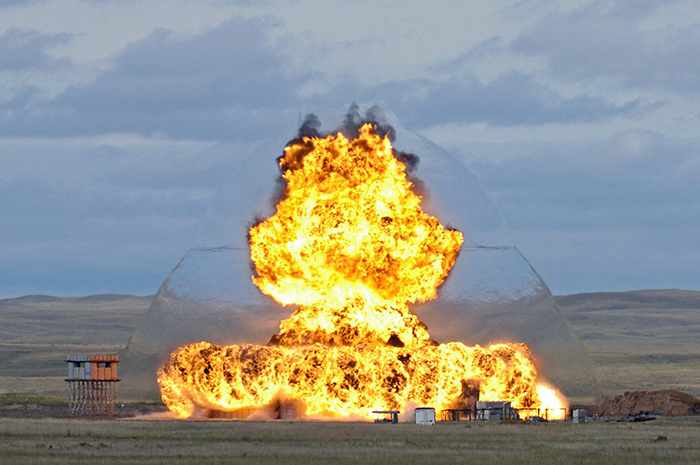Office of Research & Development |
 |


Example of an explosives trial conducted on the Experimental Proving Ground (EPG) at the Defence Research and Development Canada-Suffield Research Centre. (Photo courtesy Defence Research and Development Canada.)
October 3, 2022
By Erica Sprey and Katie Rories
VA Research Communications/VHA History Office
"The new ICD-10 code for primary blast injury of the brain is necessary to understanding, diagnosing, treating, and better understanding this injury."
Traumatic brain injury, or TBI, occurs when energy impacts the head causing brain damage. Different methods of injury can cause TBI. For example, TBI may be caused by car accidents, contact sports, or military combat.
TBI often stems from physical impacts to the head or acceleration/deceleration injuries—where the brain strikes the inside of the skull. But what about brain injury caused by a blast wave from an explosion? Should that type of brain injury be considered distinct from a TBI caused by a physical impact? The short answer is "yes."

Dr. Ralph DePalma is a trauma surgeon and special operations officer for the VA Office of Research and Development.
Blast injuries to the brain are often called “invisible injuries” because there is no evidence of an external injury on physical examination or routine medical imaging. In a blast, energy from explosive shock waves is transmitted into the brain, causing injury. "It has become clear through clinical practice and research that this type of TBI is a unique clinical entity," says trauma surgeon Dr. Ralph DePalma.
Prior to the fall of 2022, there was no dedicated medical code for blast injury to the brain. At that time, the Centers for Disease Control (CDC) International Classification of Diseases, 10th Revision, Clinical Modification (ICD-10-CM) code book contained eight separate codes for blast injury (or blast overpressure) to organs in the human body: the colon, rectum, ear, lung, bronchus, small intestine, fallopian tube, and thoracic trachea. But nothing for the brain.

VA Researcher Named One of U.S.’ Top Female Scientists

Million Veteran Program director speaks at international forum

2023 VA Women's Health Research Conference
That concern drove DePalma, special operations officer for the VA Office of Research and Development (ORD), and Dr. William Rice, an occupational medicine physician with the Department of Defense (DOD), to petition the CDC Coordination and Maintenance Committee in 2020 to create a new diagnostic code for primary blast injury of the brain.
With the assistance of team members from both agencies, it took two years to achieve their goal. The 2023 ICD-10-CM code updates, effective on October 1, 2022, contain a series of codes for "S06.8A—Primary blast injury of brain, not elsewhere classified."
The ICD-10-CM is an international coding system used by physicians, hospitals, and medical billers to classify and code medical diagnoses and symptoms. ICD-10 codes are used for billing and payment of medical services, and for ordering diagnostic tests, medical imaging, and treatments like physical therapy. They also help facilitate medical research, disease monitoring (like COVID-19 trends), and understanding health care utilization, according to Rice. The 2022 edition of the ICD-10 code book contains over 73,000 codes.
For example, if you were in a skiing accident and broke the upper bone (thigh) in your right leg, and it did not protrude through the skin, your physician would code it: S72. 91XA unspecified fracture of right femur, initial encounter for closed fracture.
"As a practicing physician, I am aware that if you write a prescription or order a lab test, you must include an ICD-10-CM code. Now, if a Veteran walks into a physician's office—outside VA—he or she can report that they had a blast exposure. With the new ICD-10 code for blast injury to the brain, a physician can bill for services and the radiologist can bill for needed specialized imaging studies," says DePalma. "It also allows the Veteran to submit a more specific reimbursement claim."
Service members (SMs) are not only exposed to blast injuries in combat, but also during training exercises. Rice, a practicing physician, cares for SMs and staff at the U.S. Army Aberdeen Proving Ground (APG), located along the Chesapeake Bay in Maryland. The proving ground was established in 1917 to support national defense during World War I.

Dr. William Rice is an occupational medicine physician at the U.S. Army Aberdeen Proving Ground in Maryland.
Beginning in 1918, personnel at APG tested field artillery weapons, ammunition, trench mortars, air defense guns, and railway artillery. Following World War, I, the base's mission shifted to ordinance training and munitions research and development. Today, APG is known for world-class research and development, testing, and evaluation of military weapon systems and equipment.
"At a training level, some of our combat systems have a high blast overpressure exposure pattern. SMs in training can be exposed to these insults on a daily basis. In occupational medicine, we're still trying to decide what constitutes a dangerous or safe level of blast exposure," says Rice. "We are also seeking to identify occupational specialties and combat systems in which these types of exposures occur."
Blast overpressure (pressure caused by a shock wave from an explosion that is above normal atmospheric pressure) is measured in pounds per square inch (PSI) or kilopascals (kPA). Research has demonstrated that 50 kPA (7.3 PSI) of blast overpressure can rupture the eardrum and cause lung injury. Hemorrhage in the lung occurs above 100 kPA (14.5 PSI) of overpressure, says DePalma. SMs exposed to 150 kPA (21.7 PSI) of blast overpressure in the field will likely experience progressive lung injury leading to death. DOD strives to limit exposures far below these levels in training.
Blast injuries to the brain can produce a wide range of symptoms; affected people can experience difficulties with sleep and problems with vision, thinking, hearing, and other sensory issues. About 20% of Veterans cared for in VA report blast exposure. The average SM who experienced an explosion is exposed to a blast about three times in combat, says DePalma.
VA and DOD researchers are investigating more sensitive ways to identify brain injury from blast overpressure. Two examples are the use of special imaging to identify subtle brain damage and measuring chemicals in the blood, called biomarkers. "We are looking for better ways to protect SMs in combat and better ways to protect them in training," DePalma and Rice note.
"Given the number of service members, law enforcement officers, miners, and others that are routinely exposed to blast overpressure, primary blast injury of the brain is an important issue in several respects. The new ICD-10 code for primary blast injury of the brain is necessary and appropriate to understanding, diagnosing, treating, and better understanding this injury."
While SMs and Veterans have been affected by blast injuries throughout history, it wasn’t until the 20th century that modern medicine was able to diagnose and treat these wounds of war.
Up until World War I, many blunt force trauma injuries to the brain from artillery shells, bullets, and other objects, were often fatal due to rudimentary battlefield medicine and high rates of infection. Many Veterans who survived these injuries often suffered from long-lasting emotional and psychological trauma. Some of them were cared for on the campuses of the National Home for Disabled Volunteer Soldiers, the Veterans Health Administration’s (VHA) ancestor.
Attempts to understand and treat these brain injuries began during World War I. “Shell shock,” the term derived during the war to understand a range of mental health issues, was originally thought to be the result of exposure to blasts. However, in 1922 the term shell shock was banned by the British Southborough Committee.
After World War II, the newly formed Veterans Bureau constructed hospitals specializing in the treatment of “neuropsychiatric” conditions affecting Veterans. Neuropsychiatric terminology such as “war neuroses,” “combat fatigue,” and “post-concussion syndrome,” became catch-all terms for what we now know as TBI and mental health conditions such as posttraumatic stress disorder (PTSD).
During the 1920s and 1930s, treatment focused mostly on recreational therapies. The Veterans Hospital in Perry Point, Maryland, was one of these specialized hospitals. Remedies included baths, massages, the “simplest forms of psychotherapy,” and above all else, rest of body and mind.
In World War II, advancements in battlefield medicine, faster evacuation time, and evolution of helmet design meant that blast injuries became more survivable than ever before. As a result, VA increased the number of mental health hospitals for Veterans to 26 and increased funding as brain injuries became an area of focus.
The Veterans Administration, at the forefront of this research, used various treatments for mental illness including insulin-shock therapy and electrical shock therapy—accepted treatments during that period—to care for psychiatric patients. In 1946, brain wave recording machines were installed in all VA hospitals to aid in the diagnosis of neurological issues. VA researcher Dr. William Oldendorf developed the prototype for the modern-day CT scanner in the 1960s. His aim was to improve diagnosis and treatment for Veterans who had experienced a TBI.
Between 1980 and 1990, TBI rehabilitation was uncoupled from other mental health issues and established as its own subspecialty of rehabilitation medicine. To address the need for TBI rehabilitation, in 1992 the Defense and Veterans Head Injury Program, later renamed the Defense and Veterans Brain Injury Center (DVBIC), was established as a collaboration between the DOD, VA, and civilian partners, with a goal to integrate specialized TBI care, research, and education across the military, Veteran, and civilian medical care system.
VA now supports longitudinal research studies that aim to discover the effects of TBI. Notably, the Long-Term Impact of Military-Relevant Brain Injury Consortium Chronic Effects of Neurotrauma Consortium (LIMBIC-CENC), a joint research initiative between DOD and VA, focuses on the long-term effects of combat-related and military-relevant mild TBI. This program has recruited a large group of Veterans with TBI, many of which have been a result of a blast-related event, as well as a control population. The introduction and use of ICD-10-CM SO6.8A will enhance research by establishing primary blast injury of the brain as a unique clinical, specific entity.
"Ultimately we [DOD Health Affairs] see this partnership with VA to establish this critical ICD-10 code as a mechanism to track the health and well-being of SMs who transition into the VA system of care," says Kathy Lee, Director of Casualty Management in DOD Health Affairs. "Initiatives such as this supports 'taking care of our people.'"
VA Research Currents archives || Sign up for VA Research updates